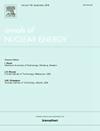Seaknot: Looking ahead of severe accident research
IF 1.9
3区 工程技术
Q1 NUCLEAR SCIENCE & TECHNOLOGY
引用次数: 0
Abstract
Severe Accidents (SAs) dominate the risk associated to the commercial production of nuclear energy. Despite the major achievements made in their research, still existing gaps, upcoming new technologies as Accident Tolerant Fuels (ATFs) and Small Modular Reactors (SMRs), more stringent safety requirements, optimization of SA management, and other factors, point the need for an efficient use of research resources in the years to come. Three major elements should integrate any SA roadmap to be proposed: preservation of knowledge and know-how; identification of key issues which research would result in the best accident management (AM) feasible; and, no less important, strengthening the workforce who will be responsible for such research. The SEAKNOT project (SEvere Accident research and KNOwledge managemenT for LWRs) was born to address this need in all and every aspect. The present article outlines the major pillars of SEAKNOT and synthesizes the progress made since its onset at the end of 2022. The methodologies adopted to develop a SA PIRT (Phenomena Identification and Ranking Table) and to build a Validation Database Directory (VADD) are described along with the ongoing phenomena listing and ranking. Besides, the first steps towards an experimental infrastructure capable of dealing with present and future needs (SAINET) are included. No less relevant the actions already made and the novelties coming on the side of knowledge and know-how transfer are also discussed.
Seaknot:展望严重事故研究
本文章由计算机程序翻译,如有差异,请以英文原文为准。
求助全文
约1分钟内获得全文
求助全文
来源期刊

Annals of Nuclear Energy
工程技术-核科学技术
CiteScore
4.30
自引率
21.10%
发文量
632
审稿时长
7.3 months
期刊介绍:
Annals of Nuclear Energy provides an international medium for the communication of original research, ideas and developments in all areas of the field of nuclear energy science and technology. Its scope embraces nuclear fuel reserves, fuel cycles and cost, materials, processing, system and component technology (fission only), design and optimization, direct conversion of nuclear energy sources, environmental control, reactor physics, heat transfer and fluid dynamics, structural analysis, fuel management, future developments, nuclear fuel and safety, nuclear aerosol, neutron physics, computer technology (both software and hardware), risk assessment, radioactive waste disposal and reactor thermal hydraulics. Papers submitted to Annals need to demonstrate a clear link to nuclear power generation/nuclear engineering. Papers which deal with pure nuclear physics, pure health physics, imaging, or attenuation and shielding properties of concretes and various geological materials are not within the scope of the journal. Also, papers that deal with policy or economics are not within the scope of the journal.
 求助内容:
求助内容: 应助结果提醒方式:
应助结果提醒方式:


